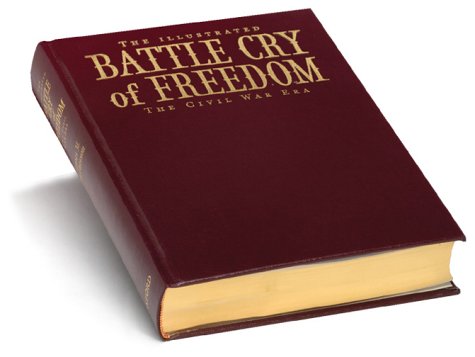
Serious Civil War buffs will delight in this magisterial treatment. McPherson's accompanying captions sometimes overdo the characterological readings (in one portrait of a Confederate general we can supposedly"almost see Breckinridge's handlebar mustache twitching in anger"), but they provide interesting biographical background as well as piquant details and an indelible period feel. This new edition eliminates the footnotes and trims a fifth of the text to make way for color maps of major battles and campaigns and hundreds of photographs, cartoons and artist's depictions from the period. Encyclopedic in scope, it synthesizes political and military history into a sweeping narrative of America's national epic, one that paints the North's victory as the triumph of a"revolutionary future" of"competitive, egalitarian, free-labor capitalism" over the tradition-bound and hierarchical society of the South. McPherson's Pulitzer Prize-winning opus is by now the standard one-volume treatment of the Civil War. This authoritative volume makes sense of that vast and confusing "second American Revolution" we call the Civil War, a war that transformed a nation and expanded our heritage of liberty. This "new birth of freedom," as Lincoln called it, constitutes the proudest legacy of America's bloodiest conflict. Eventually, the North had to grapple with the underlying cause of the war-slavery-and adopt a policy of emancipation as a second war aim. It earned a Pulitzer Prize for its insight into the social, intellectual, and economic factors that catalyzed this violent national schism between the North and South.

The book's title refers to the sentiments that informed both the Northern and Southern views of the conflict: the South seceded in the name of that freedom of self-determination and self-government for which their fathers had fought in 1776, while the North stood fast in defense of the Union founded by those fathers as the bulwark of American liberty. Battle Cry of Freedom: The Civil War Era is an analysis of the factors that led to the American Civil War, which occurred between 18. Particularly notable are McPherson's new views on such matters as the slavery expansion issue in the 1850s, the origins of the Republican Party, the causes of secession, internal dissent and anti-war opposition in the North and the South, and the reasons for the Union's victory. Packed with drama and analytical insight, the book vividly recounts the momentous episodes that preceded the Civil War-the Dred Scott decision, the Lincoln-Douglas debates, John Brown's raid on Harper's Ferry-and then moves into a masterful chronicle of the war itself-the battles, the strategic maneuvering on both sides, the politics, and the personalities. James McPherson's fast-paced narrative fully integrates the political, social, and military events that crowded the two decades from the outbreak of one war in Mexico to the ending of another at Appomattox. This “new birth of freedom,” as Lincoln called it, constitutes the proudest legacy of America’s bloodiest conflict.Filled with fresh interpretations and information, puncturing old myths and challenging new ones, Battle Cry of Freedom will unquestionably become the standard one-volume history of the Civil War.

Eventually, the North had to grapple with the underlying cause of the war, that is, of slavery, and adopt a policy of emancipation as a second war aim. McPherson puts forward important views on matters such as the expansion of slavery in the 1850s, the origins of the Republican Party, the causes of Southern secession, internal dissent and anti-war opposition in the North and the South, and the reasons for the Union’s victory.īoth North and South claimed to fight for Freedom: the South seceded in the name of freedom of self-determination and self-government for which their fathers had fought in 1776 the North defended the Union founded by those fathers as the bulwark of American liberty. It is the sixth volume of the Oxford History of the United States.įrom the momentous episodes that preceded the Civil War - the Dred Scott decision of 1857, the Lincoln-Douglas debates of 1858, John Brown’s raid on Harper’s Ferry of 1859 - the narrative moves into a masterful chronicle of the war itself: the battles, the strategic maneuvering on both sides, the politics, and the personalities.

It combines within a single narrative framework the social, military, and political events of the period. Battle Cry of Freedom covers two decades of the Civil War era, from the outbreak of the Mexican-American War in 1846 to the ending of the Civil War at Appomattox in 1865.


 0 kommentar(er)
0 kommentar(er)
